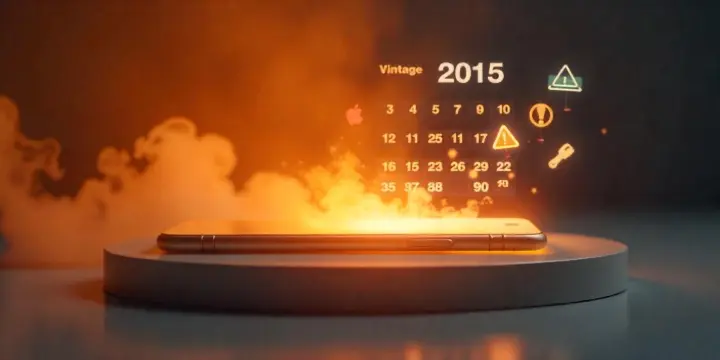Apple is a tech titan known not just for revolutionizing the smartphone industry but also for its finely tuned product lifecycle. From sleek releases to strategic software rollouts, nothing in Apple’s ecosystem happens by accident—including the moment your beloved iPhone is officially considered vintage. But what exactly does that mean, and why should it matter to the everyday iPhone user?
In this deep dive, we unpack Apple's vintage product policy, how it affects you, and what recent changes—like the iPhone 7 Plus and iPhone 8 now earning vintage status—signal about the future of your devices.
📱 What Is Apple’s “Vintage” Designation, Really?
Let’s clear up the confusion first: when Apple calls a device "vintage," it doesn’t mean the phone belongs in a museum—yet. It’s not a commentary on the phone’s age in human years (though that 2016 iPhone 7 is aging like a fine wine). It’s an internal classification system used by Apple to manage support and servicing.
In plain terms:
Apple’s vintage classification applies to devices that haven’t been manufactured for over five years but less than seven.
This window is crucial. It marks the transition from a fully supported product to one that’s slowly being phased out. While Apple discontinues routine support and won’t guarantee access to parts anymore, third-party shops and refurbished part sellers might still keep your device alive.
🧠 Wait, How Is “Vintage” Different From “Obsolete”?
A lot of users lump “vintage” and “obsolete” together, but Apple draws a hard line between the two.
- Vintage: Not produced for 5–7 years. Limited support from Apple. You might still get service at select authorized providers or third-party repair shops.
- Obsolete: Not produced for over 7 years. No support or service options from Apple whatsoever. RIP.
In short, vintage is the warning light. Obsolete is the funeral.
🆕 Latest Additions to Apple’s Vintage List

In a recent update, the iPhone 7 Plus and iPhone 8 officially joined the vintage club. As confirmed by news on Apfelpatient, these models are no longer eligible for standard Apple repair services.
This change sends a ripple across the Apple user base, especially among those who delay upgrading until absolutely necessary. These iPhones were rock-solid performers in their time—many users still carry them today. But now, things are shifting.
And let’s be honest: this shift matters more than ever in 2025, where iPhones is revolutionizing health and style. From advanced fitness tracking to seamless smart wardrobe integrations, older devices may struggle to keep up with the growing ecosystem of wellness and lifestyle tech. When your iPhone ages out, you're not just losing support—you might be losing out on innovation.
🛠️ How It Affects You: Real-World Scenarios
Let’s talk about what this really means when you’re holding a vintage iPhone.
1. Repairs Might Get Tricky
You can no longer rely on Apple Stores to carry replacement parts like batteries, screens, or cameras for your iPhone 7 Plus or iPhone 8. Some Apple Authorized Service Providers (AASPs) might still help—if they have spare parts left in stock.
Otherwise, you're heading into the third-party market, which can be hit-or-miss in quality and availability.
2. Software Compatibility Is Treading Water
While vintage doesn’t instantly kill your iOS updates, it signals you're nearing the end. Apple’s OS updates usually support devices for 5–6 years. The iPhone 8 barely made the cut for iOS 17. If you're banking on future updates or security patches, it's time to start planning ahead.
3. Trade-In and Resale Value Drops
Trade-in programs—especially those run by Apple—generally exclude vintage devices. Market resale value drops too, as users become wary of aging hardware and spotty service access.
📦 Can You Still Use a Vintage iPhone in 2025?
Absolutely. If your phone works well, isn’t damaged, and still receives iOS updates, there’s no need to panic. Many users happily stretch their iPhones to the limit—and with proper care, vintage models like the iPhone 8 can last years longer.
However, here’s the reality check:
- Accidents happen
- Batteries degrade
- App requirements increase
- Network technology evolves (hello, 5G)
So while it’s not the end, it is a reminder: you’re on borrowed time.
🧰 Your Options Moving Forward
If you’re carrying a newly vintage iPhone, you’ve got three practical paths:
✅ Stick with it—cautiously
Install the latest software updates available. Keep a close eye on performance. Use a case. And pray to the Apple gods.
💬 Look into third-party repair and battery services
Companies like iFixit and many local shops offer affordable repairs. Just ensure you’re working with certified technicians.
📱 Upgrade (even secondhand)
If you want to avoid the hassles of limited support, consider upgrading to a newer iPhone. Even buying a refurbished iPhone 11 or 12 gives you a longer runway before hitting vintage status.
🤖 Why Apple Does This: The Strategic Angle
Apple isn’t doing this out of cruelty—it’s a well-oiled business model. Vintage and obsolete classifications are part of a lifecycle that:
- Encourages upgrades
- Keeps support lean and manageable
- Reduces inventory for older parts
- Drives sales for new devices
It’s smart. Ruthless? Maybe. But undeniably smart.
🧠 Final Thoughts: Embrace the Change, But Stay Informed
Apple’s vintage policy is a subtle nudge—your iPhone still works, but its time is running out. Whether you're a tech enthusiast or a casual user, being aware of these designations empowers you to make smarter decisions about device longevity, support, and future investments.
So if your iPhone 8 has just been labeled vintage, don’t mourn it just yet. Use this moment to evaluate your needs, understand your options, and decide when (and how) to move forward in the ever-evolving Apple ecosystem.